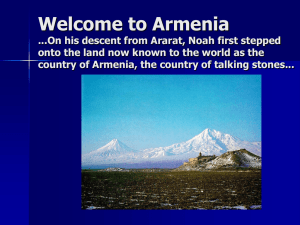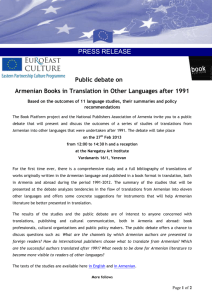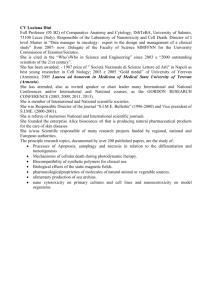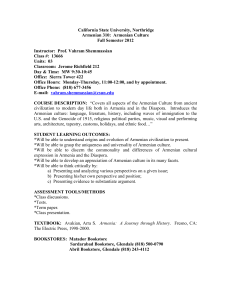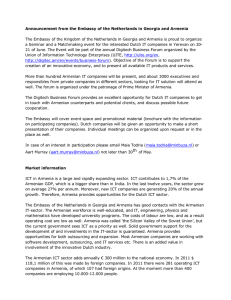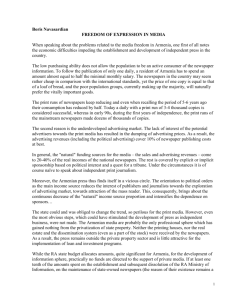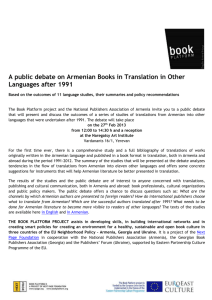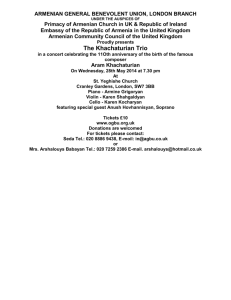Introduction - Warren Wilson Inside Page
advertisement
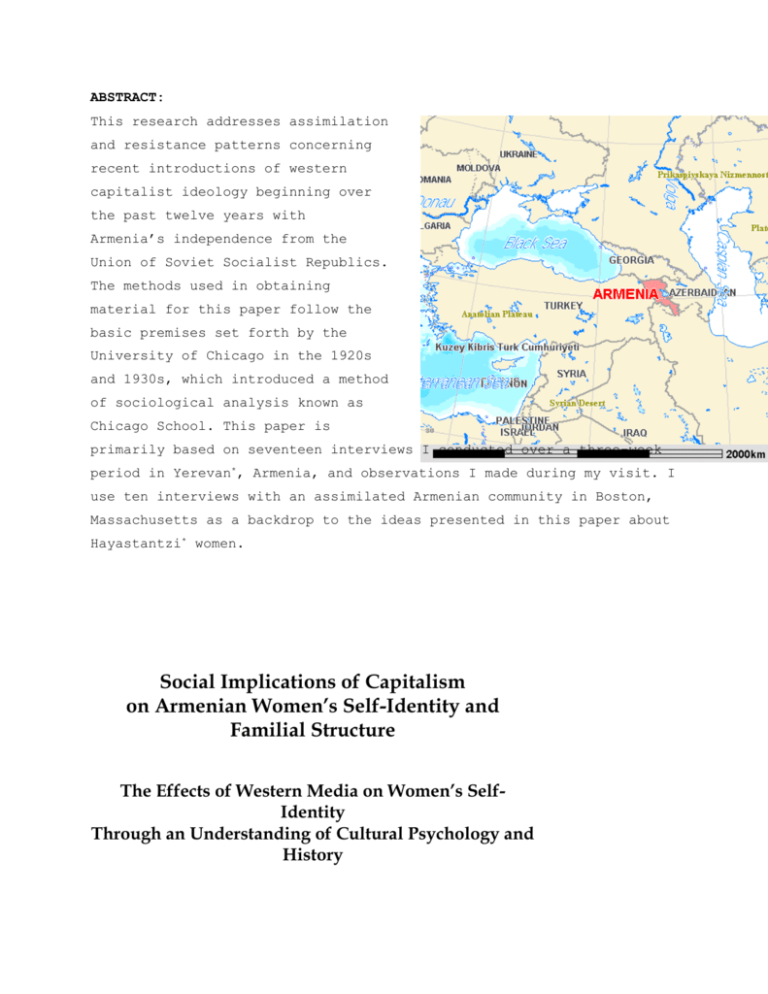
ABSTRACT: This research addresses assimilation and resistance patterns concerning recent introductions of western capitalist ideology beginning over the past twelve years with Armenia’s independence from the Union of Soviet Socialist Republics. The methods used in obtaining material for this paper follow the basic premises set forth by the University of Chicago in the 1920s and 1930s, which introduced a method of sociological analysis known as Chicago School. This paper is primarily based on seventeen interviews I conducted over a three-week period in Yerevan*, Armenia, and observations I made during my visit. I use ten interviews with an assimilated Armenian community in Boston, Massachusetts as a backdrop to the ideas presented in this paper about Hayastantzi* women. Social Implications of Capitalism on Armenian Women’s Self-Identity and Familial Structure The Effects of Western Media on Women’s SelfIdentity Through an Understanding of Cultural Psychology and History R. Byrnes Directed Research Undergraduate Senior Thesis Warren Wilson College CPO 7246 Asheville, NC 28815 The intent of this paper is to illustrate Armenian women’s attitudes toward western capitalist ideology and media in two random populations. The research consists primarily of seventeen interviews I conducted over a three-week period in Yerevan, Armenia, and observations I made during my visit. Through a series of comparative interviews, and participant observation, I have compiled information concerning the current status of the Armenian woman in the homeland. As a backdrop to the ideas presented by Hayastantzi women, I compiled ten interviews with an Armenian diasporan community which settled in the Merrimack valley of southern New Hampshire and northeastern Massachusetts. Anchored by the 19th century mill cities of Nashua, Lowell, Lawrence, and Haverhill, these communities contain old Armenian settlements dating from the early 20th century or before. I believe this research is important because while many academics have written about the process of assimilation concerning immigrant ethnicities in the United States, including Armenians, not much research has been conducted examining the effects of a new ideology in the former Soviet Republic of Armenia. Presently, there is not much research available on the area of this study. In discovering this predicament, I was forced to reference research concerning assimilation patterns for other ethnic groups. I have referenced theories concerning normalization and naturalization of social behaviors, and have gathered resources concerning the effects of media imagery on women, and combined it with the ways in which I interpreted Armenian women’s attitude toward the West and the values that are inherent in its media. As I proceeded with this project, I discovered that my hypotheses paralleled William Edward Burghardt DuBois’ theory of Double Consciousness, and Antonio Gramsci’s writings about Hegemony and Consent. In order to gain insight into the nature of how socio-economic and political transitions come through in the lives and opinions of Armenian women in the Yerevan sample, I found it helpful to reinforce my speculations and conclusions with data concerning an already assimilated Armenian community in the United States. I found that the effects of the introduction of capitalism in post-Soviet society have resounding impacts on women and family, and the upholding of tradition and ideology. Whereas most Armenian-Americans are assimilated, Armenia is in a transitional period, only recently gaining independence from the former Soviet Union. With this political independence, came a wave of economic and social influence, evident in new class distinctions and shifting traditional self-identity variables. Armenia is currently experiencing the influence of western media, which, along with new merchandises, is rapidly introducing advertising strategies, which were uncommon twelve years ago in the Soviet Republic of Armenia. Initially, I had planned to produce a comparative analysis of these populations’ perspectives on marriage, identity, and tradition. During my stay in Armenia, however, I found myself far more interested in current issues concerning western media representations of women and whether Armenian women identified with (or in opposition towards) the imagery. The material for this research was compiled using a number of research methods, including in-depth interviewing, and participant and nonparticipant observation. I conducted ten interviews in several communities north of Boston, Massachusetts with married, divorced, and widowed Armenian women who had children at least eighteen years of age. I supplemented this research with seventeen interviews in Armenia. These interviews were more diverse since I found that it was counterproductive to be too selective about respondents. By restricting respondents based on gender or marriage status I would have been overlooking perspectives I had not previously considered. Focusing on a specific group in the United States was helpful initially in creating a foundation of interest for my research. Upon my arrival in Armenia, however, I found my selection considerably narrowed by gatekeepers, so I decided to talk to everyone I could. I determined that it was in fact more productive to incorporate many different perspectives into my research, than risk making weighted judgments. While I certainly did not have access to groups of men or boys, as well as certain other social groups, I was able to speak with two men in their early twenties, two young women in their late teens, a unmarried middle aged woman, and two elderly grandmothers. The interviews, observations, and casual discussions were conducted with participants of varying social classes. I asked women in both populations to discuss their marriages, family life, gender identity, how they relate to advertising, and whether or not they consider western media to be a influence in their relationships to their Armenian heritage and ethnic identity. My conclusions yield that the adult Armenian community of Yerevan does not confront the introduction of western media with much resistance, or view it as combative towards traditional Armenian values. In fact, when asked how these women viewed western media, the consistent response was “normal.” As one typical respondent in Yerevan explained: It’s normal. I do not think it affects [people]. I tell my girls, you can’t [make a selection] from just one [choice]. They have this right to choose from several alternatives. It’s normal. While the mother of three Armenian children in northeastern Massachusetts explained, [My children] are really only allowed to watch TV on the weekends, or after they finish their homework… that’s about thirty hours a week… they don’t speak Armenian, I speak a little, I guess we haven’t had the time to teach them. I found that while media images are increasingly appealing to younger generations of Armenians in both interviewed samples, it was difficult to determine whether or not the incorporation of these images into mainstream Armenian identity was also introducing ideologies of individuality and consumerism, or if it was merely the representations of the formerly forbidden West that was so appealing to Armenians in the homeland. By comparing my research in Armenia to a thoroughly assimilated Armenian community in the United States, I was able to suggest that as Armenia becomes more westernized, citizens of Armenia will become increasingly similar to assimilated Armenian-Americans in the Massachusetts sample. At this point it is important to note that there are several significant or otherwise reoccurring themes throughout Armenia’s political history. Most importantly, we are dealing with a culture that has suffered genocide within the past century (Chorbajian), and remains with a cultural psychology wary of the future, and cautious of change. Secondly, Armenia is a very old culture pre-dating Christ. These two factors play an integral role in the formulation of Armenian nationalist identity. Finally, Armenia was a republic of the Union of Soviet Socialist Republics for seventy years, gaining independence in 1991 (Chorbajian). Armenia’s political history is intercepted with periods of war, occupation, and genocide. In 1915, Armenia fell victim to genocide at the hands of the Young Turks of the Ottoman Empire; in 1918, Armenia was incorporated into the USSR; in 1991, shortly after declaring independence from the Soviet Union, Armenia became engaged in a catastrophic war with neighboring Azerbaijan over the enclave of Nagorno-Kharabakh (Chorbajian). One of the effects of this war resulted in a four-year energy blockade imposed on Armenia, preventing access to heat, water, and light. Simultaneously, Armenia’s economy and social structure were rapidly being transformed into a systems compatible with western capitalism. This shift brought with it western definitions of womanhood, beauty, independence, and capitalist consumerism (Interviews). I argue that these introductions have now mutated into yet another form of domination we can add to the list above. As we proceed, it is imperative to keep in mind that there is a pattern of struggle and survival in Armenia’s history, and survival not only of a people but also of a tradition and history which have been subjected to a pattern of continuous threat from neighboring entities, states, religions, ideologies, and values. Currently, traditional norms and values which have survived these threats are being influenced by media interpretations of the west and its values which are admittedly attractive to a society that has been denied information about it for over seventy years (discussion, A. Aivazian). This has not necessarily been a coercive campaign, and it is certainly not a conspiracy. This situation is the result of an economic and political shift which has brought with it various types of external influence, penetrating existing systems, and fostering change. To this end, Russian and European style soap operas, American style reality shows, ads, and MTV style networks, are all part of a larger pattern or sphere of influence. Where marriage is perhaps the most important passage rite into adulthood for Armenian women in Armenia, this is not the case for Armenians in the United States. It is customary for women in Armenia to marry between the ages of 18 and 25, however there are also exceptions to this norm. Of these exceptions, a small percentage will marry later in life, but most of these women will remain unmarried, and socially stigmatized as there being something wrong or defective about them. From my interviews in Armenia, I was able to determine the extent to which social pressures persuade women to marry, oftentimes regardless of love or financial stability. Upon marriage, it is important for the bride to be a virgin, although respondents claim that this variable is changing, and there is not so much of a focus on virginity as there once was. The idea of getting married is very popular in Armenia. Women feel inferior here if they do not achieve marriage. If you are not married you are the object of social harassment and humiliation. I got married at 18, persuaded by the idea of being lonely, I was scared, so I married. At that age with that psychological aspect you cannot make the right choices. Interestingly however, being a nourp akhchig* is still one of the most important indicators of being marriage material. Literally, a nourp akhchig means “graceful girl.” Socially, the term contains other implicit understandings; briefly, these include having no history of sexual experience, being helpful, cheerful, and pleasant, following social behavioral norms, and perhaps most importantly, “knowing her place.” The women I interviewed in America come from families that have been living in the United States for at least two generations, and some emigrated as early as the 1920s; as a result many of the traditional ideas about women and womanhood have been eroded by or assimilated to the surrounding non-Armenian cultures in rather undetectable ways. However, women in Armenia are still only recently being confronted with an outright and persistent capitalistic invasion, clearly represented through the media, imported goods, and advertisements. I found that for the most part, Hayastantzi women are unenthusiastic about their daughters/other Armenians adopting western standards of identity; however many respondents said they didn’t believe their daughters were influenced by the media. Most respondents claimed advertisements go unnoticed and do not have any impact on passersby. While Armenian women in the United States strongly identified with their heritage, they were less suspicious of these influences, as this population has assimilated over the past century. Interestingly, respondents in the United States pointed to media, consumerism, and public schools as the leading factors drawing their children’s attention away from interest in the Armenian language, and their general identity as Armenian. A common response from these women was that their children were much more concerned with the level of their assimilation as illustrated through commodities and other commercial engagements. A responded from the interviewed sample in the United States confesses, [My son] is far too preoccupied with his friends at [high school] and hanging out, any time I’ve asked him to come to one of those Armenian functions he refuses. There is only so much I can do… I think it is important for him to feel like he fits in. I believe the strongest components of western influences on Armenian women in the United States are the surrounding non-Armenian cultures, and the media. As western media is rapidly becoming integrated into the existing Armenian culture in the homeland and in the Massachusetts sample, it is exposing women to its inherent values, including rapid product consumption, adventures in promiscuity, classist opinions of others represented through brand-flashing, and certain neuroses concerning body image and conceptions of beauty which are not compatible with general Armenian physicality. One experience I had with a young girl in Armenia helps to illustrate these obsessions; she kept a box of magazine ads and clothing tags from name-brand American clothing and cosmetics including Gap, Express, Limited, and Revlon. She presented the box to me as one of her prized possessions was very proud to show me that she owned Nike sneakers, which her aunt had mailed to her from the States. Women in Armenia undergo a socialization process which encourages them to mold themselves according to the indicated desires of their fathers and husbands while television plays a pivotal role in the introduction of other values. During my research in Armenia, I noticed that televisions and advertising bring American concepts of individuality, which clash with my understanding of the values of traditional Armenian society; these included familial dedication, focus on community well being as opposed to individual impulse, and respect for history and tradition. It is reasonable to assume that younger generations of Armenian women in Armenia will become more westernized because of these influences, similar to their ethnic counterparts in the United States, and change will cause a generational rift in ideological priorities between the young female generation, and their parents’ and grandparents’. Both interviewed groups of women identify themselves as Armenian women, and subscribe to traditional Armenian gender roles, however the degree to which these identifications are made is different for each group. These differences are illustrated through respondents’ answers to the following line of questioning; “what values that you consider typically Armenian did your parents raise you with, do you communicate similar values to your children, do you see your children straying from these values, in what ways?” Respondents in Armenia communicated that a respect for Armenian tradition and language, as well as respect for parental authority and tradition were very important for their children to have. These women also listed the ability to perform wifely responsibilities as an important indicator of the caliber of one’s character. Respondent 1: The wife must always make the smoke in the house go out the chimney, and keep the fire down. The wife must know her place and limits, this is the key, this is strength, to turn away when you're wrong. Respondent 2:I give permission to my husband; I don’t make a big deal because it is not worth the problems that will arise. Respondent 3: Very few women are satisfied (Armenia) with their marriages. Women are not taught to find happiness outside the house, socially, and the men are very happy to have their wives sit at home, and the first to blame in this case is the woman. Respondent 4: This new generation is looking for other things. We [wives] used to make sure everything would be fine, to make it so there were no problems, do the laundry, make dinner on time, but today, the problems come from outside the home, economics etc. Women in the United States answered that there weren’t any specifically Armenian values that they were raised with, or that they were trying to communicate to their children, with the exception of knowledge of Armenian history, predominantly the Armenian Genocide, and respect for the culture and language. When asked how they went about instilling these values in their children, they listed commemorating April 24th*, and enrolling their children in Sunday school*, as well as maintaining strong relationships with grandparents. Relationships built by women between themselves and their families and larger society impact their relationships toward external social pressures. These connections are more distinct for women in Armenia, and disconnection from stereotypical and traditional identity is more difficult for them to obtain than for the Armenian women I interviewed in the United States because there are overwhelming social pressures for them to adhere to norms. Most families in Yerevan live in apartment buildings, consisting of two or three bedrooms. Sometimes families turn a balcony area into an extra bedroom, and many families have pullout cots or mattresses in case there visiting guests or family members. Due to rotted natural gas lines in the city, the great majority of homes are heated with small space heaters. Due to widespread unemployment, families cannot afford extra expenses often resulting in entire flats being heated by two or three space heaters of the type designed to keep bathrooms warm. As a result, in the winter, entire families gather to keep warm in single rooms with closed doors. The doors between rooms are kept closed because the rest of the house is unbearably cold. The rest of the house includes the kitchen and bathroom. It was my impression that wives (many of which do not work outside the home) spend large parts of their days between the kitchen and the bathroom. These are the rooms where women prepare meals, coffee, hand wash laundry in often-unheated water, and organize activities for guests and children. Because most of these women do not have microwaves, dishwashers, laundry machines and dryers, or even reliable access to hot water, the responsibilities that could theoretically take several hours to complete, end up taking all day and most of the evening. In my interviews, I was curious to know what Armenian wives though the concept of a “good Armenian wife” entailed, considering that this phrase is often referred to when discussing Armenian wifehood. Being a good Armenian wife is a term that is commonly used in a positive way to grant social acceptance of a new bride in the Armenian community, perhaps comparable to being a nourp akhchig. Respondents’ answers in the United States were varied, however some central themes did emerge. Have you heard the concept of “the good Armenian wife”? Respondent 1: Well, of course. [Laughter] What does it mean? Respondent 1: Well, one of [my husband’s] friends said something, it was a real put-down, we had gone camping and he said to me, “How come the fire isn’t ready and breakfast isn’t ready?” I looked at him and said, “What?” And he said, “Well any good Armenian [original emphasis] wife would have started the fire by now and the breakfast would have been on the table.” And I said, “That’s funny, I was expecting you to do that, I am not your maid.” And he said, “It figures [my husband] would have a wife like that—an Armenian who is acting improper,” or something equally as stupid. He said that in front of [your husband]? Respondent 1: Yes, and [my husband] said, “Oh, get over it [to his friend], you make the fire and I’m going to make breakfast for her,” and it was incredible to me that he would actually say something like that, even though I know that [Armenian men] still think this way, that it is the woman’s job to serve the man as soon as he comes through the door, they still believe that. It’s probably going to change with the next generation, but it’s there, and it’s a learned thing. You learn it at home, and you expect your wife to be the same way. [That man] wasn’t happy because I knew what he meant the moment he said it. Was [the comment] supposed to intimidate me? I found that the most agreed-upon variables for good marriages in Armenia were, respect, love, communication, and love for the groom’s parents. Other sentiments included the importance of Armenians marrying each other. These responses were similar or both groups of respondents. Since Armenia gained independence from the USSR, nearly thirty-five percent of the population has emigrated to the United States or other parts of the Armenian diaspora, including Russia, Syria, Lebanon, Egypt, France, and Canada. This large shift in population is compounded by the dispersion of Armenians between the late-1800s and early 1900s, during which time Armenians were fleeing sporadic Ottoman massacres, culminating in the genocide of 1.5 million Armenians between 1915 and 1918. These events are largely responsible for populations of Armenians all over the world, in which Armenians have intermarried people of non-Armenian heritage. Many of the respondents in Armenia communicated that while it was an important factor in their marital decision, and that they would like to see their children marry Armenians, they would allow their children to marry non-Armenians. In contrast, Armenian-Americans felt very strongly about their children marrying Armenians. From the Armenia sample, 95 percent agreed that marriage was important in order to find fulfillment in life. Of these, only 25 percent said that they would completely object to their children marrying nonArmenians, and 50 of the 95 percent claimed that mixing of ethnicity through marriage was not inherently wrong, but rather that trying to combine two different lifestyles, histories, cultures, and possibly languages, is difficult for couples and would be hard or confusing for children. A respondent from the sample of Armenian-Americans discusses her perspective on inter-ethnic marriage: Respondent 2: I talk to my [Armenian] friends from different countries—even here when I have friends who are raising kids here—and they’ll say, “don’t mix the odars*,” and I think, “Why? You live here; you have to work with them. Even the generation that’s younger than [my husband] and I, they say that they don’t socialize with Americans. We’re the only couple I know that has American-born friends. None of the Armenians from Armenia or Iran do; I even hear the Armenian-Americans say, “Oh, I’m never going to have an odar husband or wife. I mean, [my husband’s] mother still will not accept the Irish. She would say things about the Irish, the drinking or whatever. It’s incredible, but I think Jews are the same way, not just Armenians, the one’s who’ve been persecuted like the Armenians feel they need to keep their identities protected. I have Jewish friends and I hear them say their parents would “go nuts” if they married non-Jews. So, for you, is it important that [your child] marries an Armenian? Respondent 2: Hopefully she wont feel forced to marry an Armenia. We don’t want to be like that. The divorced women in Armenia whom I spoke with claimed that they divorced in much the same way as women in America. Generally, papers are signed and spouses separate, leaving the children to either visit between both spouses, or live with the parents of the bride. Rarely are children sent to live with the groom’s family. After divorce, it is much easier for a man to remarry than a woman. Divorced women in Armenia are perceived to be imperfect in some way, and they are often the subject of family ridicule and social gossip. I had the privilege of interviewing one woman in Yerevan, Armenia, who was thirty-three years of age at the time of the interview, and who had been married for eleven years to a man whom she divorced three years prior to the interview. In this interview, the respondent explained her history with marriage, why she married, what the marriage was like, why she divorced, and the social predicament she finds herself in as a result of her decision. The perceptions and attitudes this respondent discusses, on being a divorced, single female at her age, I feel, are an accurate illustration of the general mentality in Armenians held towards women in her situation, however few the number of women in this category may be. Can you discuss your history with marriage for me? Respondent 3: The idea of marriage is very popular in Armenia. First, women feel inferior if they do not achieve marriage. If you are not married you are the object of social harassment and humiliation. What do you mean by harassment and humiliation? Respondent 3: Oh, other women will talk about you with each other, at home, in the workplace. They will make you feel very uncomfortable, like there is something wrong with you. Very often they will not take you seriously. My interpretation of social views of divorce, based on interviews and observation, is that women in Armenia literally fear divorce; perhaps beyond the extent that one generally fears rejections of any kind. There are tremendous social pressures for young women to be desirable to men, and these pressures manifest themselves in many different ways, both in and outside the privacy of the home. Within the home, young girls’ attention is drawn to the fact that their success depends on several factors; outstanding academic performance, being attractive as a bride, and knowing the socially constructed limits of one’s place as a daughter, wife, and mother. Armenia’s seventy-year history as a republic of the Union of Soviet Socialist Republics had a weighty influence on its collective cultural psychology. The USSR placed significant importance on quality education and dedication to work (SOVIET BOOK *****). These pressures remained after the fall of the Union in 1991. When were you married? Respondent 3: I got married at eighteen, which is not considered too young, by the way. Can you describe your experience with marriage, and why you chose to divorce? Respondent 3: At twenty-nine or thirty, [after about ten years of marriage] I wanted my husband not to be a nominal person who has the idea of a successful marriage in the eyes of society, but as a supporter of the family. He could never support me. I was the breadwinner, and this made him feel very uncomfortable. He could never do it for me; he felt that because we did not have children he could just quit the family and go on. Now he is married with children. I believe myself to be lucky to escape a mentality such as that. How do you view your divorce? Respondent 3: Financially, I do not depend on anybody. I earn my money—quite legitimately by the way—and I have worked hard to deserve that which I have. I am a specialist. I am able to earn my bread and butter and this makes everyone mad. Financial and sexual independence is not welcome here. However, people [in Armenia] pretend that they are free and a democratic country, and deny these traditions, but these traditions definitely exist and influence their mentality. How do your friends and family view your decision to divorce? Respondent 3: My family is heavily against the idea of my divorce. You will excuse me, but I am considered an attractive woman, and when I am with married couples, women always feel uncomfortable around me. There is an unwillingness to accept an unmarried woman, and it is jealousy. They are scared. Perhaps they think I can capture their husbands. What are some of the difficulties of your lifestyle? Respondent 3: I am not someone who can just pick up an accidental partner. Not because I am an Armenian woman (respondent’s emphasis). I tend to want a real partner, and that is a psychological connection. [Here], either women wear the label of whore or they don’t do it [engage in pre/extra-marital relations], and I prefer the latter. But a man will come with flowers and presents and when he offers marriage and you decline, he is awfully surprised “You, divorced! How can you reject me? Alone!” One of them told me that I am out of my wits. How do men relate to you? Respondent 3: For example, I went to a party, and this man brought a cake, expensive, for 100 guests, and there were foreign guests, and I had guests from Moscow, and as this man was interested in politics I was an interlude, I was changing languages like gloves, and I was exchanging ideas, and the guests were really shocked and as he hopes to make a good career, when we walked out he said it should be difficult for me to be partners with you because you are superior, and as a wife what are you going to do? I said if I agree to become your wife, you should make a brilliant career! This is an investment. I work at myself, I cannot be concentrated on preparations for some man, I have priorities also. Do you consider yourself a feminist? Respondent 3: No. I am quite feminine; I like these flowers, and my makeup and dresses. If I have a man, he will carry my suitcases. I can carry my own bags, but if I am alone, I don’t carry it, some man will. But I can (respondent’s emphasis). It is cheaper to pay an instant helper than a husband, during all your life. I am a very good cook, I am total woman, but I cannot bear the idea of having extra weight. I was depressed in my marriage. This generation can change if they realize their powers. When everything is forbidden, people long for it. The fruit that is forbidden is sweet, as they say. If god did not forbid eating the apple, nobody would even care. There is no creativity. My students have asked, how do you manage to dress so nice. I say because I approach the issue like a scholar. I investigate the styles from all over and then I create my own. And you simply follow what you are told is beautiful and fashionable and that is why it is a complete failure. People have been living for 70 years (USSR) with limits from the Soviets. Constant fear, historic fear. If you buy many things, you are psychologically insecure, and also there is the situation of the genocide. Armenians were allowed to have property, but were never given the chance, and so they have been glued to this obsession. Perhaps there is a victim mentality. If I am given the chance I shall work hard and I shall find a sphere to display my abilities. I am seized by a passion for perfection, and so I am not happy yet. This impetus moves the world forward, because if we are all always satisfied there can be no movement. Both samples of women (Hayastantzis and Armenian-Americans) believe that marriage is one of the defining characteristics of womanhood. However, this sentiment was much more popular among women in Armenia. Divorce is more common in the US, and more accepted by family members and social networks, however it certainly takes place in both societies. In an effort to gain insight into the manifestation of gender roles in society, it is helpful to look at the way men and women speak to each other. Men and women’s language differ from each other in several ways. There is a slight disparity in the types of vocabulary they use, and syntax and body language further clarifies this difference. Both women and men use the word “yerevi,” which means “perhaps,” however, I heard women use it more then men, and they both use it more than Americans do. It is tempting to hypothesize that social conditioning encourages women to use this word so often, because it reinforces (both to themselves and to others) the supremacy of the male gender over the female; her ideas, her vocabulary, her integrity. Perhaps women say it so often because they have normalized and internalized containment of their womanly natures. If generations of women are socially conditioned by their fathers, brothers, and husbands to follow what these men say and do, suggesting that women are inferior, would not a time come when women would begin to view this behavior as normal? Is it not possible to see how oldergeneration women might encourage male dominance by transmitting the ideology of male superiority to young girls? In this dialogue, I asked an Armenian-American women about gender conditioning: Did your parents encourage you and your sister to be feminine or domestic? Respondent 4: No, no, it have to be a certain way don’t sit with your legs was all these things—put was just [that] you when you’re a woman, open, even as a kid it on a skirt, be quiet. For example, a grandmother who has learned her whole life that her husband and father are disinterested in her opinions, might normalize the situation, and try to save her granddaughter some “pain and aggravation” by telling her to be quiet, or making her help in the kitchen and not concern herself with men’s affairs. The argument here is that the “perhaps” is only a tool in a much larger structural system to reinforce gender identity divisions. Another way men’s language is different is that it is socially accepted for men to be loud when they talk in groups. Men can be loud either through body language (dismissive gestures), or in the actual volume of their speech. Women can be loud when speaking in a group of women, however, if other men enter, the dynamic in the room changes. A personal experience will reflect this situation. When a male friend of mine in Armenia and I would go out to see his friends, right before we reached our destination, he would hold my arm and say “don’t say anything unless I introduce you.” This routine is important because after I heard him say this, I was too nervous to say anything, so I stood like piece of furniture while he spoke with his friends. Sometimes, if the friends thought I did not speak Armenian, they would subtly ask him who I was; he would reply that I was a friend. Maybe this does not have as much to do with language, as it does with power in social settings, but I think it would be very hard for him to keep me quiet if it were socially acceptable for me to articulate myself in that setting. Dismissive body language is very popular among men in Armenia. There are several hand gestures and certain sounds one can make to show that what is being said is inaccurate or unworthy of attention. I am not certain that all women are exposed to these types of interactions, however I was exposed to it and watched other women respond to it. The women I watched react to these behaviors did not seem upset or offended in any way, and sometimes responded in an equally assertive manner, conveying to their partner what their intentions were. The way women in Armenia view themselves is changing; this is visible in social and familial settings, and especially clear by comparing the way older generations of women assert themselves as opposed to younger women. Up until 1991, media in Armenia was owned and operated by Russia and was mostly used as a propaganda tool to present its own values and interests (SO***). Presently, as Armenia races to integrate itself with the rest of the capitalist world, its markets have opened to western media. The images and ideas communicated though Europeanstyle soap operas and American-style reality shows, are vastly different than traditional Armenian values, or even values co-opted during its union with the Soviets. In a country where community reliance is a vital component of history and survival, these new values threaten the sustainability of culture and tradition. The influence of media on women in both countries has a profound effect on Armenian national, ethnic, and individual identities. In Armenia, media representation of women was one of the most fascinating aspects for me when juxtaposed with traditional ideas of womanhood. Similar to girls in the United States, young women in Armenia are confronted with MTV-like representations of femininity and womanhood. These representations include flightiness, promiscuity, sexual “independence,” bi/homosexuality, provocative wardrobes, and a general disregard for authority, tradition and social order. Media imagery is extremely influential on young women in glorifying consumerism and an American interpretation of individuality (Brown, 1990). A grandmother in Yerevan states, Girls today are very different, too free, they want everyone to look at them, they worship the current fashions, they go to these bars and discos and they are just too free. They want to have everything immediately, and they don’t understand what it means to wait. My personal response to this discovery was that I was witnessing a clear shift in ideology between generations. Two thoughts led me to this conclusion. First, Armenia is a small, poor country, whose markets have only recently opened to capitalist enterprise. The easiest market in this situation would be children, especially young girls, who can grow up watching Western renditions of glamour and independence from their living rooms. Armenian parents, who traditionally express familial dedication through providing gifts for their children, are bound to this market in a rather ironic manner; in keeping with their desires to deliver presents to their children, they cannot ignore that the gifts the children are wanting are more and more dictated by what is glorified through advertising and the media. Consequently, gifts that were at one time surprises for children, are now dictated by children. This change does not only affect the economy, but also intra-family communication and traditional power relations between family members previously dictated by age and gender. This process becomes cyclical and self-strengthening when parents’ purchasing of these products, and their subsequent endorsement of the values represented in the items, support the market for the items in the country. By adhering to tradition (i.e. acquiring gifts) they are actually greasing the wheels of assimilation. Because Armenia’s economy has not completely adjusted to capitalist investment and structure, these purchases are a crucial component in the continued vitality of the economy (Khachatrian, Eurasianet.org). As it is my opinion that this process is fundamentally detrimental to the sustainability of Armenia’s traditions and culture, I asked a group of married women who had children to discuss commercial media, consumerism, women in advertising, the effects on their children, and Armenia as whole; some of their responses follow: What are your attitudes concerning the effects of western media on your children? Respondent 5:They don’t affect my daughter, she views them as normal. What do you mean by “normal?” Respondent 5: Ads don’t bother her, she never complains or anything. What about western movies that depict violence, sex, and other representations of adult conducts? Respondent 5: We can’t be having sex scenes in movies. We never know when these movies are going to be on, they are not just late at night, at any time one could come on the screen. Respondent 6: If the children are taught well, they accept it as part of the movie. It is all the responsibility of the parents. Respondent 7: My kid has never picked up a gun, and he questions killing in movies, but there are other people who will join the army just to kill. Respondent 8: We see the stripteases, and the kids think that that stuff is normal and easy. They don’t understand that it takes a lot to make money to have that. They watch these movies about being rich and think that it will all come naturally and they don’t known what sweat it will take to earn their first dollar. Respondent 9: [The Armenian people] want to give everything to their children. This is wrong. For example, we let ourselves suffer all day and night for our children. This is wrong. This was more the generation before us (age 35), now we mothers want something for ourselves too. Respondent 10: There can be nothing without advertising, but I get sick of it, there are too many, and it is past its measure. It isn’t a problem for me that there are half nude odars in commercials. You can’t hide it from the children anymore, it is human nature, but the children don’t need to see it. We need to start accepting homosexuality, I’m a little more free minded, liberal, whatever happens out there that doesn’t interfere with my life is fine, let them do it, I don’t want it in my house, but it isn’t my business what others do with themselves. The second thought that led me to recognizing this perceived natural process of the introduction of western advertising as cultural warfare or cultural imperialism is that as western ideas are incorporated into mainstream life, preexisting thought patterns and traditions are slowly erased, replaced, or assimilated into the recent exposure. This process slowly, and virtually undetectably paves the road to cultural homogenization. In a case such as Armenia, where a great majority of the nation’s energy, food, and capital is imported, the nation cannot easily refuse economic support, thus it is forced into this position because it is almost entirely dependent on import. While young women in Armenian yield to traditional womanliness, and do not raise their voices to their fathers, grandmothers or brothers, when they are out with friends, they can practice some of the rebellion they watch on TV. Here we find the manifestation of expectations of young women to play a double role. The only time I witnessed women acting like girls in Western-style soap operas, MTVlike music video programs, and Reality TV, was when they were together, and even then they faced being talked about after the girls separated, as having loose morals or being disrespectful. But perhaps it is unrealistic to expect media to not have an influence. Some example of the ads in Armenia (below) illustrate some of the “other” ideas I have been referring to. We can think of this ad as The Attack of the 50ft Western Ideology. The size of this woman’s hips and length of her legs are not typical of Armenian women’s bodies, which are generally short and round. Gigantic Aryan woman superimposed over a small Armenian Man. My interpretation of this ad is that it symbolically represents ideological worship of one culture and domination of another. The representations of women in advertising in Armenia are quite similar to ads aired in the United States. Some women in advertisements are depicted with Scandinavian physicality; often including narrow shoulders and hips, thin waist lines, light brown or blond hair, and light eyes. More often, however, there are Armenian commercials, which use Armenian models that are darker skinned with dark eyes and hair. These models also have exaggeratedly slender figures, which are not genetically typical for Armenian women. Models are dressed in expensive-looking European styles, including short, tight outfits, and high-heeled, point-tipped shoes, which appeared uncomfortable and impractical for day-to-day living in Armenia. During my stay I did not come across a single advertisement depicting women in anything less than ultra-feminine attire. Some of the effects of advertising, as discussed above, include a psychological standardization and rationalization of the imagery in the minds of viewers. This normalization results in a subconscious endorsement of gender roles and stratification. This is another illustration of signals encouraging certain worship. These images juxtaposed with traditional thoughts, border on pornography according to one elderly grandmother in Yerevan. She explained, There is no need to see things like this. These images are everywhere. If I want to turn the TV on during the day, I cannot be sure that there will not be some kind of inappropriateness. They have nude women on there all the time; this is not what I want my grandchildren watching… That advertisement [depicted above] goes unnoticed I am sure, but what is not to notice about it?” This billboard for Samsung Electronics not only illustrates a huge material worship of the primary medium through which western influence is reaching Armenia, but it also depicts a scantily clad woman in a provocative position inside the system. Self-identity is affected by social/cultural understandings (Smith in Garner, 2001). When a surrounding society disapproves of certain behaviors, the individual is pressured/taught not to behave in those ways (Smith in Garner, 2001). While women in Armenia are afforded with social reliance, they are less networked than Armenian-American women; there are few public resources from which women can expect social services. Women in Armenia must maintain their identities and inter-familial struggles against harsh and often unsympathetic opposition. We find the existence of double consciousness under these conditions. This concept holds for both women in Armenia and America; women in Yerevan expressed that they feel it because they are both trying to maintain a traditional identity (which is expected and helps them socially), and they are trying to identify with the western world. Armenian-American women feel it in a similar way, in that they are also trying to maintain an Armenian identity, but at the same time, they are living in America, where they find that they must adopt (at least some of) the values and ways of the larger society. According to DuBois’ theory of Double Consciousness, there are two components which produce one’s self-image; there is the core identity one possesses as a member of a particular group, and there is the image of self which is constructed to fit the norms of the social pressures and variables which are projected onto it (Garner, 2001). In applying this theory of self-identity to the women discussed in this paper, we see perhaps, a clearer illustration of the effects of social and cultural pressures on the individual. While women in Armenia are drawn from the direction of tradition towards a large array of western values, Armenian-American women are drawn in the opposite direction, from their American lifestyles towards Armenian heritage and identity. What is most important in this equation, however, is that the bonds between the former, are exponentially stronger than what binds the latter. In the case of Armenian-American women, the desire to reconnect to their heritage is a remote reality, and one they know is actively distancing itself. The attitudes demonstrated by women in Armenia about media imagery and western values as an unavoidable course of nature, are less clearly present in the responses of women in the United States, however I found that they were also quite present. This position of relative indifference is discussed by Gramsci in his theory of hegemony and power relations. Gramsci’s theory of hegemony discusses the process by which one group uses power and influence through a particular non-coercive discourse to influence another less powerful group. These relationships display the dichotomy of power between those with influence and those without (Garner, 2001). I use hegemony to explain Armenians’ reactions to western media since its recent infiltration of post-Soviet Armenia. All of my respondents claimed that these transitions and images were “normal.” For Gramsci, this is the discursive power of a regime which rules without coercion, but by appealing to the common sense of the masses (Gramsci in Garner 2001). In the case of Armenia, we have a society that has been closed to the west for seventy years; a society, which under the USSR was not permitted or encouraged to examine social phenomena from a sociological perspective. In light of this history, it should not come as a surprise that the media imagery from the west is not being scrutinized from any analytical perspective. According to Henry Huttenbach of the City College of New York, cultural recovery after genocide depends on the existence of the following eight categories: A viable demographic survival rate, high or increased birth rate, charismatic leadership, common language, common religion, an anti-assimilation mentality, political asylum (diaspora), and the concept of a homeland (Huttenbach, 2002). Without one of these categories, after genocide, Huttenbach argues that a people face great difficulty maintaining ethnic and cultural identity. In the case of the Armenian people, who suffered genocide at the hands of the Ottoman Turks (1915-1921), it is easy to recognize some of these categories. The Armenian people’s cultural identity is intimately connected to their Christian faith of 1700 years, their Armenian language, 100 years of asylum in the United States, Syria, Lebanon, Egypt, Russia, and Europe, and a profound loyalty to their homeland. These four categories are readily apparent to an observer. The categories that are not fulfilled, however, are also important to note. For example, Armenia does not have a relatively high demographic survival rate, in light of the massive emigration from the country. While the Armenian diasporan population is quite large, and Armenia’s national birth rate has been rising since 1970 (www.nationbynation.com), emigration is also rising. Armenian also has a fairly corrupt political system; in recent presidential elections several presidential candidates were harassed or assaulted. Beyond these factors, and perhaps most importantly, Armenians neither in the homeland nor in the population I spoke with in the U.S. presented any firm anti-assimilation mentality. Without these last four components, it is feasible to understand the ideological shift which I argue is approaching Armenia, with minimal resistance. My findings to date are significantly inconclusive, in part due to the complexity of the topic; however, I feel there are several points that should be revisited. Firstly, I have presented an illustration of Armenia’s current socio-economic condition, as it is relevant to a general over-view of the country’s political and historical background. From this context, emerges the pattern of domination of a country by penetrating exterior entities. I argue that the emergence of western media and advertising, as well as a rapid influx of western ideology is—if not outright cultural imperialism—resulting in an ideological pivot and a shift from traditional priorities concerning community and family, towards individualism and mass consumerism. Secondly, I have attempted to draw a parallel between an assimilated Armenian community, and the direction in which Hayastantzis are headed. Due to the general lack of resistance towards assimilation, the illustrated pattern of assimilation will continue. Relatedly, Gramsci’s warnings that widely held perceptions of top-down influence as normal or natural lay the foundations for increased concentrations and strengths of power over an increasingly powerless larger population. Finally, I believe that Henry Huttenbach’s list of variables that must exist in order for a culture’s traditions to recover after genocide, are completely relevant to the particular case of Armenia and the Armenian diasporan communities. Drawing from my experiences while conducting this research and living in Armenia, I believe that I am writing these thoughts in a period of time which is critical for Armenia and Armenians. If the historic as well as the current traditions are to continue following their gradual pattern of transformation, I believe we are headed in the direction of largescale assimilation and homogenization of a culture at the hands of western cultural imperialism. * Yerevan is the capital city of Armenia, with a population estimated at 600,000, although a formal census has not been issued since Armenia was a republic of the USSR. * Hayastantzi is an Armenian term used to distinguish Armenians born in Armenia from Armenians born in the diaspora. * Nourp Akhchig literally translates to “graceful girl,” however it is also a term women come to identify themselves with early in life. * April 24th is an internationally recognized day for the commemoration of the Armenian Genocide. * Many Armenians in the United States enroll their children Sunday Schools which are religiously based, and which tie Christianity to Armenian history and traditions, helping to foster strong Christian and Armenian identity. * Odar is an Armenian word referring to people of non-Armenian ethnicity.
